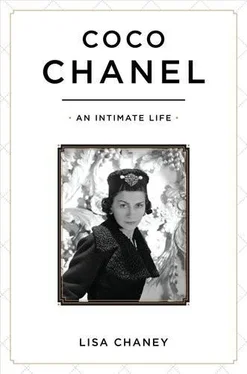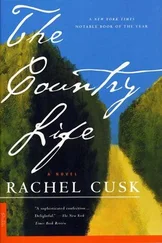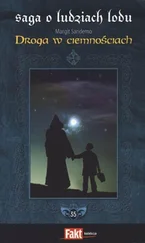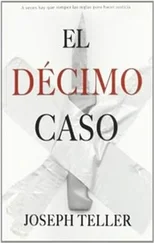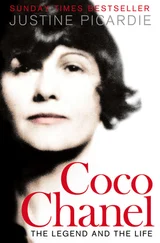Lisa Chaney
Coco Chanel: An Intimate Life
For Anna
(And in memory of our mother, Elizabeth [1923–2009])
“Capel said, ‘Remember that you’re a woman.’
All too often I forgot that.” 1
Gabrielle (Coco) Chanel was a woman of singular character, intelligence and imagination. These attributes enabled her to survive a childhood of deprivation and neglect and reinvent herself to become one of the most influential women of her century. Unlike any previous female couturier, her own life quickly became synonymous with the revolutionary style that made her name. But dress was only the most visible aspect of more profound changes Gabrielle Chanel would help to bring about. During the course of an extraordinary and unconventional journey — from abject poverty to the invention of a new kind of glamour — she helped to forge the idea of modern woman.
Leaving behind her youth of incarceration in religious institutions, Gabrielle became a shop assistant in a town thronging with well-to-do young military men from the regiments stationed on its perimeter. She then threw away any chance of respectability by becoming mistress to one of them, and over the years her numerous subsequent liaisons were much talked about. Her relationship with Grand Duke Dmitri Pavlovich was a remarkable reflection of changing times, while that with the fabulously wealthy Duke of Westminster was the stuff of legend. Her love affair with one of Europe’s most eligible men, the enigmatic playboy Arthur Capel, enabled her to flourish, but would end in tragedy.
Aside from her dark beauty, Gabrielle was described as “witty, strange, and mesmerizing.” She would become the muse, patron, collaborator or mistress of a number of remarkable men, including some of the most celebrated artists of modern times. These included: Picasso, Cocteau, Stravinsky, Visconti, Dalí and Diaghilev. In addition, Gabrielle rose to the highest echelons of society; created an empire; acquired the conviction that “money adds to the decorative pleasures of life, but it is not life”; became a quintessential twentieth-century celebrity and was transformed into a myth in her own lifetime.
To those already interested in her, the general outline of her life is well-known. Gabrielle’s story is one of drama and pathos, and I had become intrigued, though I doubted that there was much left to discover. Her first biographer, Edmonde Charles-Roux, appeared to have found all that the passage of time and Gabrielle’s concealment of her past would permit. Subsequent biographers had accepted this state of affairs, and thus various periods in her life remained unknown. My interest had been caught, though — among other things, by the variety and caliber of artists whom she had known, artists instrumental in the creation of modernism in early twentieth-century bohemian Paris. Simply retelling the rags-to-riches narrative and listing the sartorial changes she is credited with inventing don’t do justice to a woman who played a part in the formation of the modern world, not only its clothes but its culture.
As I became more familiar with her story, the gaps grew more tantalizing. While that first biographical interpretation had stamped itself upon the general perception of the woman who became Coco Chanel, intuition told me things were subtly different. She left behind few letters and no diaries. Believing, nevertheless, that I might be able to turn up some new details, I embarked on early reconnaissance. Little did I know then the trails I was to follow and the raft of discoveries I would be fortunate enough to make over the next four years. As these new elements of her story gradually fell into place, more light was in turn thrown on Gabrielle’s character.
Her dreadful childhood was obviously critical, but while her own version shifted like the sands, I found treasures once I had learned how to filter her storytelling. Gabrielle often tells us as much about herself in what she left out or altered as in what she chooses to reveal. Approaching her from a peripheral viewpoint was also fruitful. Had so-and-so known her? If so, what had been written up in his or her diaries or letters? One line here, another there in a letter or an interview became crucial to the expanding story.
I traveled to Ireland to meet Michel Déon, who had spent a great deal of time with Gabrielle sixty years before. As a successful young novelist he had been commissioned to write her biography. I returned with no new “facts” but something more important. Michel Déon had regaled me with anecdotes, interspersed with the sharpest of observations. At the same time his compassion for her was instrumental in the development of my ability to comprehend her lifelong emotional plight. Her vulnerability was largely concealed, but it contributed to her isolation.
The reminiscences of those who had known her were invaluable, but other sources were also critical. An introduction to the American Russianist William Lee, for example, brought about his translations of a number of Duke Dmitri Pavlovich’s diary entries, sent to me via installments over several weeks. These have revised our understanding of Dmitri and Gabrielle’s affair. They reveal quite a different relationship from the one traditionally described, which has Gabrielle the man-eater being mooned over by the young aristocrat.
My confirmation of Gabrielle’s rumored bisexuality and drug use is important. Other discoveries were perhaps even more so, because they opened up deeper, sometimes disturbing questions about her.
After months of searching, one day I sat with the son-in-law and grandson of Arthur Capel, unquestionably the great love of Gabrielle’s life. His family had no more than snippets of information about their elusive forebear. This included the complex triangular relationship involving him, Gabrielle and the woman he would marry instead, Diana Wyndham. But what I heard that day set me on the trail of this extraordinary man — who Gabrielle said had made her — and the discovery of the poignant details of their affair.
During part of the Second World War, Gabrielle lived in occupied Paris at the Ritz with Hans Günther von Dincklage, a German. The other “guests” were German officers. It was already established that von Dincklage had done some prewar spying for his government. On meeting Gabrielle, according to the standard story, this had ceased and he had become “antiwar.” Gabrielle and von Dincklage’s affair, and his wartime activities, have been only partially known. However, a cache of documents about von Dincklage in the Swiss Federal Archives, some in the French Deuxième Bureau and yet more information in other unlikely places have made it possible to give a fuller account of this reprehensible man than ever before. A master of seduction and deception, he was without question a spy. Yet while Gabrielle was undoubtedly a survivor, I don’t believe she ever knew this. Nevertheless, after the war she thought fit to remove herself to neutral Switzerland so as to avoid any possible proceedings against her.
Having closed her couture house during the war, in 1954 she returned to it. At first a failure, in time she once again became a world-class couturier. Her myth, which she nurtured, grew until it was sometimes impossible to distinguish it from the real woman. As one of the pioneers of modern womanhood Coco Chanel personified one of its greatest dilemmas: fame and fortune versus emotional fulfillment. Her myth was sometimes a substitute; by the end of her life she had little else. Her carapace of inviolability, her wall of self-protection raised up over the years, meant that few were able to reach her. In her last years, increasingly autocratic, she remained formidable. Her loneliness was sometimes tragic.
Читать дальше
